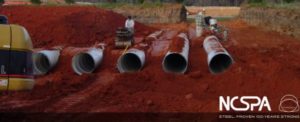By: Southeast Culvert, Inc

Maximizing Efficiency: Low Impact Development Solutions for Sustainable Stormwater Management
Firstly, in the year 2016, a significant shift occurred within the Atlanta region. The Atlanta Regional Council, in their commitment to environmental stewardship, amended the Georgia Storm Water Management Manual. Subsequently, this revision mandated the integration of Low Impact Development (LID) water quality methods into construction projects. Therefore, organizations like Jacob’s Ladder, a non-profit dedicated to supporting families with children facing neurological disorders, found themselves needing to adapt their Storm Water Management Systems (SWMS). To address these new regulations, and considering the site’s unique challenges, the engineer of record, AEC, Inc. of Roswell, GA, sought out Southeast Culvert. They tasked them with designing not only cost-effective detention facilities, because budget constraints were a paramount concern, but also robust filtration solutions, hinting at the later incorporation of an 84-inch aluminized sand filter, to ensure optimal water quality.
Navigating Soil Challenges for Optimal Low Impact Development Solutions
Furthermore, during the initial site assessment, a critical challenge emerged. Specifically, the site revealed a stark contrast in soil conditions. Half of the area exhibited acceptable percolation rates, whereas the remaining portion displayed none. Indeed, this disparity underscored the inherent difficulties of implementing LID methods in clay-rich soils. Nevertheless, Southeast Culvert rose to the occasion. For the front catchment, they engineered a 42-inch perforated, aluminized infiltration system. This system, importantly, aimed to return stormwater directly to the earth, thus mimicking natural hydrological processes.
Innovative Engineering for Enhanced Low Impact Development Solutions

Moreover, the back catchment required a more robust approach. Consequently, an 84-inch aluminized sand filter was incorporated, paired with a 72-inch underground detention system. This combination, crucially, was designed to achieve an impressive 80% Total Suspended Solids (TSS) removal rate, thereby significantly improving water quality. In this instance, Corrugated Steel Pipe (CSP) options proved to be the most financially viable choice. Additionally, the inherent flexibility of the CSP product allowed AEC and Southeast Culvert to seamlessly integrate multiple functions into a single, efficient system. Ultimately, the ability to tailor the system to the specific site conditions was key to the project’s success.
Cost-Effective Low Impact Development Solutions and Environmental Responsibility
In conclusion, the project at Jacob’s Ladder demonstrated the practical application of updated stormwater management guidelines, specifically those outlined in the Georgia Storm Water Management Manual. By strategically utilizing CSP, Southeast Culvert was able to deliver cost-effective and environmentally sound Low Impact Development Solutions that met the unique challenges presented by the site’s varied soil conditions. This project serves as a testament to the importance of innovative engineering and adaptability in achieving sustainable development goals, while adhering to the rigorous standards set forth in the Georgia Storm Water Management Manual.
Related Stories(Opens in a new browser tab)
Eco-Friendly Military Access Roads: Deep Corrugated Buried Bridges Reduce Environmental Impact(Opens in a new browser tab)
The Measured Performance of Aluminized Type 2 Steel Pipe in Storm Sewer Applications
Building Steel Bridges: A Sustainable Solution for Windfarm Access Roads